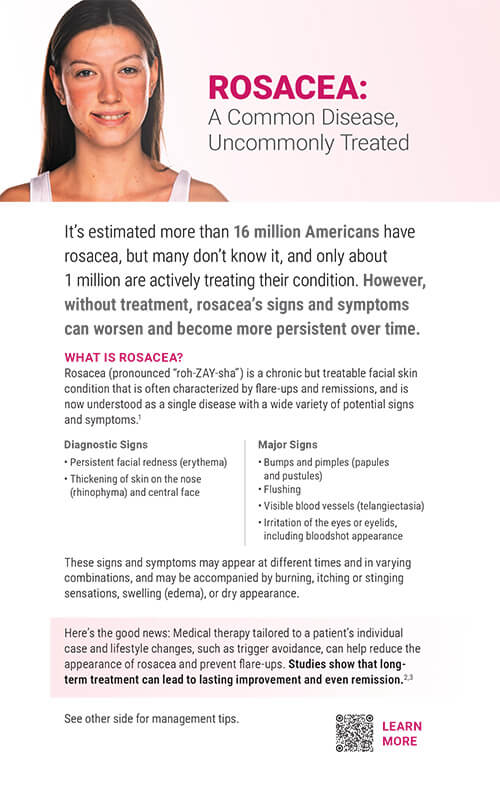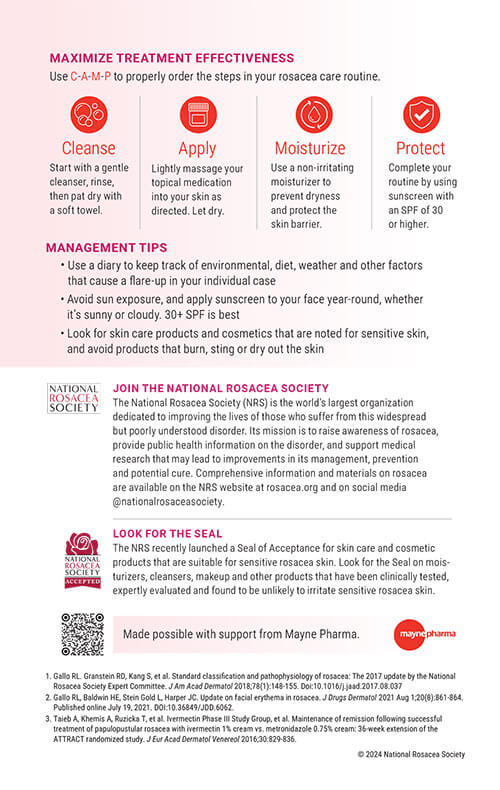Download a free PDF or read it online:
 It’s estimated more than 16 million Americans have rosacea, but many don’t know it, and only about 1 million are actively treating their condition. However, without treatment, rosacea’s signs and symptoms can worsen and become more persistent over time.
It’s estimated more than 16 million Americans have rosacea, but many don’t know it, and only about 1 million are actively treating their condition. However, without treatment, rosacea’s signs and symptoms can worsen and become more persistent over time.
What Is Rosacea?
Rosacea (pronounced “roh-ZAY-sha”) is a chronic but treatable facial skin condition that is often characterized by flare-ups and remissions, and is now understood as a single disease with a wide variety of potential signs and symptoms.1
Diagnostic Signs
- Persistent facial redness (erythema)
- Thickening of skin on the nose (rhinophyma) and central face
Major Signs
- Bumps and pimples (papules and pustules)
- Flushing
- Visible blood vessels (telangiectasia)
- Irritation of the eyes or eyelids, including bloodshot appearance
These signs and symptoms may appear at different times and in varying combinations, and may be accompanied by burning, itching or stinging sensations, swelling (edema), or dry appearance.
Here’s the good news: Medical therapy tailored to a patient’s individual case and lifestyle changes, such as trigger avoidance, can help reduce the appearance of rosacea and prevent flare-ups. Studies show that long- term treatment can lead to lasting improvement and even remission.2,3
Maximize Treatment Effectiveness

Use C-A-M-P to properly order the steps in your rosacea care routine.
- Cleanse
Start with a gentle cleanser, rinse, then pat dry with a soft towel. - Apply
Lightly massage your topical medication into your skin as directed. Let dry. - Moisturize
Use a non-irritating moisturizer to prevent dryness and protect the skin barrier. - Protect
Complete your routine by using sunscreen with an SPF of 30 or higher.
 Management Tips
Management Tips
- Use a diary to keep track of environmental, diet, weather and other factors that cause a flare-up in your individual case.
- Avoid sun exposure, and apply sunscreen to your face year-round, whether it’s sunny or cloudy. 30+ SPF is best.
- Look for skin care products and cosmetics that are noted for sensitive skin, and avoid products that burn, sting or dry out the skin.
Join the National Rosacea Society
The National Rosacea Society (NRS) is the world’s largest organization dedicated to improving the lives of those who suffer from this widespread but poorly understood disorder. Its mission is to raise awareness of rosacea, provide public health information on the disorder, and support medical research that may lead to improvements in its management, prevention and potential cure. Comprehensive information and materials on rosacea are available on the NRS website at rosacea.org and on social media @nationalrosaceasociety.
Look for the Seal
The NRS recently launched a Seal of Acceptance for skin care and cosmetic products that are suitable for sensitive rosacea skin. Look for the Seal on moisturizers, cleansers, makeup and other products that have been clinically tested, expertly evaluated and found to be unlikely to irritate sensitive rosacea skin.
References
1. Gallo RL. Granstein RD, Kang S, et al. Standard classification and pathophysiology of rosacea: The 2017 update by the National Rosacea Society Expert Committee. J Am Acad Dermatol 2018;78(1):148-155. Doi:10.1016/j.jaad.2017.08.037
2. Gallo RL, Baldwin HE, Stein Gold L, Harper JC. Update on facial erythema in rosacea. J Drugs Dermatol 2021 Aug 1;20(8):861-864. Published online July 19, 2021. DOI:10.36849/JDD.6062.
3. Taieb A, Khemis A, Ruzicka T, et al. Ivermectin Phase III Study Group, et al. Maintenance of remission following successful treatment of papulopustular rosacea with ivermectin 1% cream vs. metronidazole 0.75% cream: 36-week extension of the ATTRACT randomized study. J Eur Acad Dermatol Venereol 2016;30:829-836
Made possible with support from Mayne Pharma.